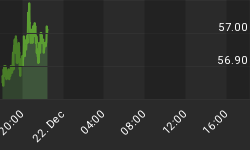In my last commentary entitled "Inflation, Deflation, Reflation," we considered the possibility that the next 5-6 years will witness a continuing cycle of inflation, followed by deflation, followed by reflation, with trading ranges in the equities, currency, and bond markets. This also presupposes a "trading range" of sorts in the U.S. economy. But what would this "Inflation, Deflation, Reflation" (IDR) scenario mean for the gold market?
The trading range financial markets/economy over the next few years is a good possibility based on the fact that there are no two back-to-back up years between now and until around 2009 in the grand scheme of the 120-year Master Cycle (discovered by Samuel J. Kress). Greenspan and company have also made it clear through their actions that they will stop at nothing to keep the economy afloat to "sustainable levels."
Before examining the issue of how the gold market can be expected to perform in a trading range economy, I'd like to share some valuable insight from someone who read my previous article on this subject. He writes, "I feel we [will] get hyperinflation (i.e., the Weimer Republic-type 1922 style) FIRST. This is because the Fed can do nothing more now than print like crazy to keep the deflationary scenario away, which is obviously the worst outcome. However, after the wheelbarrow paper dollar thing, the buck is junk and then we go the other way with a vengeance. Then comes the dreaded deflation, lasting probably for years. I hope and pray the aftermath does not turn into violence and/or a civil war. Read history regarding the French Revolution. It's a duplicate and so are many other cases. I say we get both, one after the other. And who knows the timing? No one knows. It just seems obvious if you can understand the positions of the authorities and human nature. Let's hope for the best -- a peaceful outcome and a continuation of freedom and liberty for our beautiful country."
Another reader wrote the following response, "Your view of the trading range Greenspanian outlook for the economy has some upsetting implications. And I say this with regard to the move in gold that many of us have hoped' would gain some traction for a move higher than just the $400 level, so that some of these costs of production and currency transaction issues can be defrayed at the mines. I wonder if the picture you have painted should logically imply a sideways market for gold as well, since you are looking for these kinds of possible symmetry in stocks, bonds, and the dollar over the long view?"
Let me interject here and answer that a trading range stock/bond/currency market does not necessarily imply a "stuck-in-the-mud" gold market. Keep in mind that gold has always been the investment of choice during periods of financial and political uncertainty. Investors turn to gold when nothing else seems to be working and sustained capital appreciation isn't forthcoming in the traditional investing instruments (stocks, bonds, etc.) Bear markets are characterized by agony and frustration, and nothing is more agonizing than a seemingly endless trading range. When investors begin to figure out that "buy and hold" no longer applies as the "easy" way to wealth in the financial markets, they'll turn to precious metals. We've already gotten a small taste of this in the past two years. I'm firmly convinced the best is yet to come in the gold and silver markets.
What do the charts say? By examining the long-term gold chart we arrive at two upside targets over the next 1-4 years: $450-$460 and $650-$700. Both of these targets are derived from taking measurements from a simple (yet highly reliable) trend line measuring formula. But let's not stop there. Let's take our analysis of gold's long-term chart a step further by employing the extremely reliable form of chart analysis known as "parabolic analysis."

When a series of parabolic price cycles are drawn around gold's 22-year priceline, we see a bullish-looking parabolic bowl which has been gradually rounding over the past few years and has just started to push prices higher. The incline of this bowl is still rather shallow (relatively speaking), although with each passing year the "rim" of the bowl becomes steeper. The parabola in the long-term gold chart strongly suggests that gold has seen its price low for this decade.
Moreover, a series of bowls can be drawn in the long-term gold chart beginning with the late 1987 peak to the present and also from the 1996 peak to the present. All of these patterns combine to form a picture of increasing strength and momentum, and it suggests that the long-term accumulation process is nearly complete with the long-awaited mark-up process about to begin.















